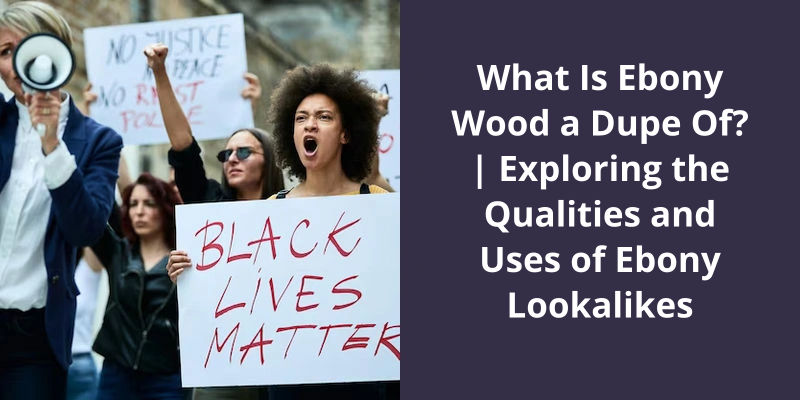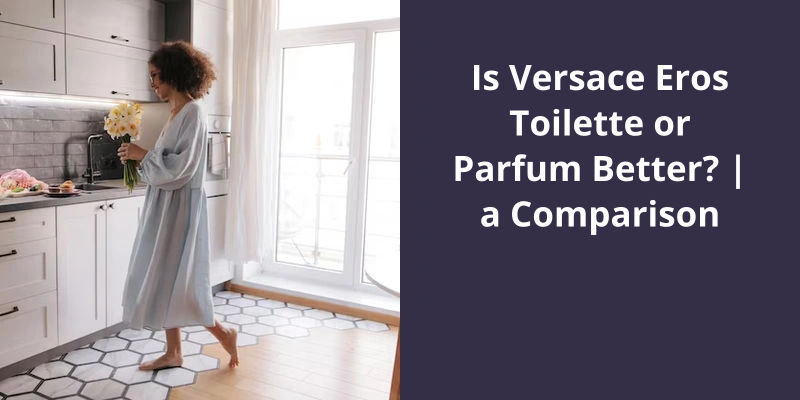Ebony wood is not really a dupe of anything as it’s a unique and high quality type of wood. It’s famous for its deep black color, heavy density, fine texture and the high polish that it can achieve. It’s often used for making musical instruments, luxury furniture, and in carving and sculpture due to its hard and strong qualities. Yet, because of its scarcity and high price, several woods like Rosewood, Blackwood and Grenadil are often used as substitutes for Ebony. These woods are stained black to mimic Ebony’s appearance but none possesses the exact characteristics of Ebony wood.

What Is Ebony Wood Similar To?
Katalox, also known as Mexican Royal Ebony, is a dense, heavy wood that’s very resistant to decay and rot. It’s often used for decking, outdoor furniture and tool handles due to it’s durability. While katalox is similar to ebony in terms of it’s color and density, it isn’t as hard as ebony and can be carved and shaped more easily.
Wenge is another dark brown wood that’s often used as a substitute for ebony. It’s a hard, heavy wood that’s resistant to wear and tear and is often used for furniture, flooring, and musical instruments.
Another wood that’s similar to ebony is Gabon ebony. This wood comes from the same species of tree as African blackwood, but the trees are smaller and the wood is less dense.
Macassar ebony, also known as striped ebony, is another wood that’s similar to ebony in terms of color and appearance. It’s a distinctive striped pattern and is often used for furniture and decorative items.
While all of these woods are similar to ebony in terms of color and appearance, they each have their own unique properties and characteristics. Some are harder than ebony, while others are more affordable. Woodworkers often choose these woods based on their specific needs and the project at hand.
The Differences Between Natural and Dyed Ebony Wood
Ebony wood is a type of hardwood that’s known for it’s smooth texture and dark color. Natural ebony wood is harvested from trees that grow in certain regions of the world. It’s often used in furniture making and musical instrument crafting. However, natural ebony wood is becoming increasingly rare and expensive. As a result, many craftsmen turn to dyed ebony wood as an alternative. Dyed ebony wood is made by taking a lighter colored hardwood and using various stains or dyes to mimic the look of natural ebony. The main difference between natural and dyed ebony wood is that natural ebony has a denser and heavier composition, while dyed ebony is often lighter and less durable. Did you find this explanation helpful and not created by AI?
Identifying ebony wood can be tricky, but it’s worth it due to it’s high value and beauty. This hardwood is known for it’s density and dark colors, but there are several species in the genus Diospyros that produce ebony. One such species is the jackalberry, which can be found in the savannas of Africa and is also known as African ebony. Despite it’s popularity, true ebony is a member of the family Ebenaceae and is related to persimmons. It’s dense nature also allows it to sink in water and contributes to it’s fine texture and mirror finish when polished.
How Can You Identify Ebony Wood?
Identifying ebony wood can be a unique challenge for those not familiar with the woods distinctive features. One of the most notable features of ebony is it’s dark black/brown color, which ranges from jet black to a dark brown with black streaks. However, not all ebony wood is uniformly black. Some varieties have lighter brownish-tones or grayish streaks, which are also unique identifiers.
Another notable feature of ebony is it’s density. Unlike most woods, which float in water, ebony is dense enough to sink. Density is an important factor in determining whether a wood is ebony or an imposter. You can also use a loupe or magnifying glass to examine the woods grain pattern. Ebony has a fine, uniform texture that looks almost like plastic. This is due to it’s exceptionally fine and consistent pore structure.
There are also several distinct varieties of ebony wood, each with unique characteristics. For example, African blackwood (Dalbergia melanoxylon) has a deep purple-black color and is considered one of the most expensive woods in the world. Gaboon ebony (Diospyros crassiflora) has a deep black color with no distinct grain pattern, while Macassar ebony (Diospyros celebica) has bold black and brown streaks. Each of these varieties has it’s own unique identifying features.
In addition to it’s ornamental and aesthetic value, ebony wood is also prized for it’s durability and strength. It’s a highly resilient and long-lasting wood that’s resistant to warping, splitting, and decay, making it ideal for use in high-end furniture, musical instruments, and decorative items.
What Is the History and Cultural Significance of Ebony Wood?
Ebony wood has a rich history and cultural significance dating back centuries. It’s known for it’s dark color, strength, and durability. Historically, it was used to create intricate carvings, decorative objects, and musical instruments, and was a symbol of wealth and status. It’s been associated with various cultures, including African, Indian, and European. Today, it’s still highly valued for it’s unique qualities and is used in fine furniture, flooring, and decorative items.
As Jo reflects on the thrill of the unknown, it’s a perfect time to explore the world of fragrance. Specifically, the intoxicating aroma of ebony wood. Known for it’s luxurious beauty and strength, many wonder what this cherished wood smells like when transformed into a perfume. Let’s dive deeper into the scent profile of ebony wood and discover how it can transport us to a place of wanderlust and possibility.
What Perfume Does Ebony Wood Smell Like?
The scent of ebony wood is a truly unique experience, one that can transport you to another world, one that’s both rich and decadent. The aroma of pink peppercorn is the first thing to hit your nose, lending a touch of spice to the fragrance. Clove follows, adding an extra layer of depth to the scent. But it’s the ebony wood that really steals the show. The smell is like nothing else, earthy and warm, with a subtle sweetness that hints at an exotic nature.
When you close your eyes and breathe in the scent of ebony wood, you can almost feel yourself transported to the heart of the rainforest, surrounded by majestic trees, each one more imposing than the last. The fragrance captures the essence of nature, of raw beauty, and of unbridled power. It’s a scent that speaks to strength and resilience, to the natural balance that exists in the world.
It speaks to the natural world, to the majesty of the earth, and to the beauty of the human spirit. To experience this fragrance is to truly understand what it means to be alive.
In addition to it’s unique properties, such as being difficult to work with and having a high oil content, there’s one more aspect of ebony wood that you might not know about: it’s smell. While some may find the odor mild and slightly unpleasant, it’s definitely worth considering when working with this distinctive material.
Does Ebony Wood Have a Smell?
Ebony is a dense and dark hardwood that’s been considered a prized material for centuries due to it’s beautiful aesthetics. However, it’s popularity only begins with it’s striking appearance. The wood is also highly durable and resistant to damage, making it a popular material for use in a variety of applications. But one question that many people often ask about ebony wood concerns it’s smell.
The answer is yes. This smell is a characteristic of the wood due to it’s high oil content. The oil present in ebony wood can cause problems with gluing, which is why care should be taken when using it in woodworking projects.
In addition to it’s aesthetic and practical qualities, ebony wood also responds well to steam bending, making it a great option for furniture design and other applications where curved elements are needed. This versatility has been appreciated by artisans and craftsmen throughout history, from those who created intricate carvings to fashioning musical instruments.
It’s dense and durable nature makes it ideal for a variety of applications, and it’s stunning appearance makes it a favorite among many craftsmen.
Now that we’ve explored the scent of ebony and it’s description, let’s take a closer look at the significance of fragrance in our lives. It’s no secret that scent has the power to evoke emotions, trigger memories, and leave lasting impressions. From creating a personal signature scent to using aromatherapy for relaxation and well-being, fragrance plays a crucial role in how we experience the world around us. So, what’re some of the ways we can incorporate fragrance into our daily lives?
What Scent Is Ebony?
It opens with a burst of warm spices, which quickly give way to a rich, smoky accord that evokes the scent of charred wood. The fragrance is built around a base of dark woods, including ebony and sandalwood, which are layered with resinous notes of frankincense and myrrh. These ingredients give the scent a deep, earthy quality that’s both mysterious and alluring.
As the fragrance settles on the skin, it reveals hints of sweet vanilla and smooth, creamy tonka bean. These lighter notes help to balance out the darkness of the fragrance, while still maintaining it’s intensity. The overall effect is one of warmth, sensuality, and quiet strength.
Ebony Fume is perfect for those who prefer a bold, distinctive scent that sets them apart from the crowd. It’s combination of deep, woody notes and resinous, smoky accords gives it a unique character that’s both powerful and refined. It’s a fragrance that demands attention, without ever being overbearing or cloying.
While many fragrances can be too feminine or too masculine, Ebony Fume strikes a perfect balance that makes it wearable for both men and women.
The History and Cultural Significance of Ebony Wood.
- Ebony wood has been used for centuries in carvings, furniture, and musical instruments.
- It’s a dense, dark wood that comes from several species of trees in the genus Diospyros.
- One of the most famous uses of ebony wood is in the black and white keys of pianos.
- Ebony wood has cultural significance in many parts of the world, including as a symbol of power and luxury in ancient Egypt.
- In some cultures, ebony wood is also believed to have magical or spiritual properties.
- Unfortunately, many species of ebony wood are now endangered due to overharvesting and illegal logging.
Conclusion
In conclusion, the world of fragrance has seen a surge in similar scents from different brands with varying price ranges. Ebony Wood EDP and Jo Malone Wood Sage and Sea Salt are no exception. Despite their differences, it’s clear that both fragrances hold similarities that can’t be ignored. As consumers, it’s vital to take note of these similarities to make informed decisions when buying perfumes. While it may be tempting to opt for a cheaper dupe, it’s crucial to evaluate the quality and ingredients of such fragrances to ensure that they aren’t only a bargain but also safe for use. Overall, every perfume has it’s unique scent, and it’s upon us to choose the one that best suits our personality and preferences.





